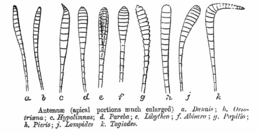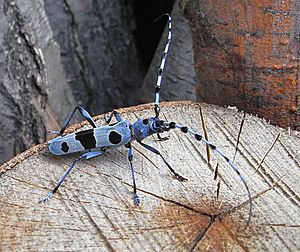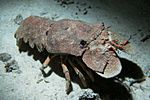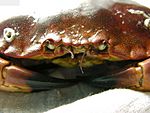Antenna (biology) facts for kids

Antennae (singular antenna) are paired feelers (appendages) connected to the front segments of crustaceans and insects. They are found on the first two segments of the head. The smaller pair is known as antennules.
Antennae are jointed and extend forward from the head. They are sensory organs. The organ may sense touch, air motion, heat, vibration (sound), and especially olfaction (smell) or gustation (taste).
Insects

Antenna are the primary olfactory sensors of an insect and are accordingly well-equipped with a wide variety of sensilla (singular : sensillum). Paired, mobile, and segmented, they are located between the eyes on the forehead. Embryologically, they represent the appendages of the second head segment.
All insects have antenna though these may be greatly reduced in the larval forms. Amongst the non-insect classes of Hexapoda, Collembola and Diplura have antenna, but Protura do not.
Structure

The three basic segments of the typical insect antenna are the scape (base), the pedicel (stem), and finally the flagellum, which often comprises many units known as flagellomeres.
Muscles are only present in the two first segments, the scape and pedicel. The scape is surrounded by a membranous region of the head. It pivots on a single marginal point called the antennifer, allowing it to move in any direction.
The number of flagellomeres can vary greatly, and is often of diagnostic importance. True flagellomeres have a membranous articulation between them, but in many insects, especially the more primitive groups, the flagellum is entirely or partially composed of a flexible series of small annuli, which are not true flagellomeres.
In many beetles and in the chalcidoid wasps, the apical flagellomeres form a club, and the collective term for the segments between the club and the antennal base is the funicle; for traditional reasons, in beetles it is the segments between the club and the scape, but in wasps, it is the segments between the club and the pedicel.
In the groups with more uniform antennae (for example: Diplopoda), all segments are called antennomeres. Some groups have a simple or variously modified apical or subapical bristle called an arista (this may be especially well-developed in various Diptera).
Functions
Olfactory receptors on the antennae bind to odour molecules, including pheromones. The neurons that possess these receptors signal this binding by sending action potentials down their axons to the antennal lobe in the brain. From there, neurons in the antennal lobes connect to mushroom bodies that identify the odour. The sum of the electrical potentials of the antenna to a given odor can be measured using an electroantennogram.
In the case of the Monarch, it has been shown that antennae are necessary for proper time-compensated Sun compass orientation during migration, that antennal clocks exist in monarchs, and that they likely provide the primary timing mechanism for Sun compass orientation.
Crustaceans
Crustaceans bear two pairs of antennae. The first pair are uniramous and are often referred to as antennules, while the second pair are biramous, meaning that each antenna is composed of two parts, joined at their base . In most adults, the antenna are sensory organs, but they are used by the nauplius larva for swimming. In some groups of crustaceans, such as the spiny lobsters and slipper lobsters, the second antennae are enlarged, while in others, such as crabs, the antennae are reduced in size.
-
A spiny lobster, showing the enlarged second antennae
Images for kids
-
Electron micrograph of antenna surface detail of a wasp (Vespula vulgaris)
See also
 In Spanish: Antena (artrópodos) para niños
In Spanish: Antena (artrópodos) para niños







